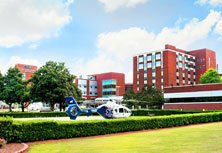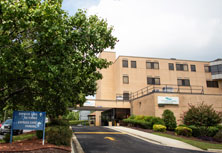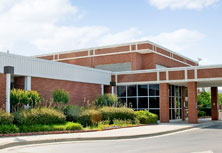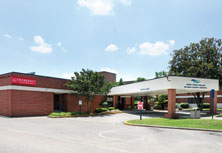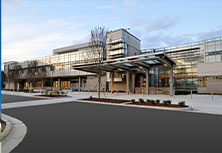Thyroid
Your thyroid gland is one of the endocrine glands that make hormones to regulate physiological functions in your body, like metabolism (heart rate, sweating, energy consumed). Other endocrine glands include the pituitary, adrenal, and parathyroid glands and specialized cells within the pancreas. The thyroid gland is located in the middle of the lower neck, below the larynx (voice box) and wraps around the front half of the trachea (windpipe). It is shaped like a bow tie, just above the collarbones, having two halves (lobes) joined by a small tissue bar (isthmus.). You can't always feel a normal thyroid gland.
What is a thyroid disorder?
Diseases of the thyroid gland are very common, affecting millions of Americans. The most common thyroid problems are:
- An overactive gland, called hyperthyroidism (e.g., Graves' disease, toxic adenoma or toxic nodular goiter)
- An underactive gland, called hypothyroidism (e.g., Hashimoto's thyroiditis)
- Thyroid enlargement due to over activity (as in Graves' disease) or from under-activity (as in hypothyroidism). An enlarged thyroid gland is often called a goiter.
Patients with a family history of thyroid cancer or who had radiation therapy to the head or neck as children for acne, adenoids, or other reasons are more prone to develop thyroid malignancy.
If you develop significant swelling in your neck or difficulty breathing or swallowing, you should call your surgeon or be seen in the emergency room.
What treatment may be recommended?
Depending on the nature of your condition, treatment may include the following:
Hypothyroidism treatment:
Thyroid hormone replacement pills
Hyperthyroidism treatment:
- Medication to block the effects of excessive production of thyroid hormone
- Radioactive iodine to destroy the thyroid gland
- Surgical removal of the thyroid gland
Goiters (lumps)
If you experience this condition, your doctor will propose a treatment plan based on the examination and your test results. He may recommend:
- An imaging study to determine the size, location, and characteristics of any nodules within the gland. Types of imaging studies include CT or CAT scans, ultrasound, or MRIs.
- A fine-needle aspiration biopsy a safe, relatively painless procedure. With this procedure, a hypodermic needle is passed into the lump, and tissue fluid samples containing cells are taken. Several passes with the needle may be required. Sometimes ultrasound is used to guide the needle into the nodule. There is little pain afterward and very few complications from the procedure. This test gives the doctor more information on the nature of the lump in your thyroid gland and may help to differentiate a benign from a malignant or cancerous thyroid mass.
Thyroid surgery may be required when:
Historically, some thyroid nodules, including some that are malignant, have shown a reduction in size with the administration of thyroid hormone. However, this treatment, known as medical suppression therapy, has proven to be an unreliable treatment method.
What is thyroid surgery?
Thyroid surgery is an operation to remove part or all of the thyroid gland. It is performed in the hospital, and general anesthesia is usually required. Typically, the operation removes the lobe of the thyroid gland containing the lump and possibly the isthmus. A frozen section (immediate microscopic reading) may be used to determine if the rest of the thyroid gland should be removed during the same surgery.
Sometimes, based on the result of the frozen section, the surgeon may decide not to remove any additional thyroid tissue, or proceed to remove the entire thyroid gland, and/or other tissue in the neck. This decision is usually made in the operating room by the surgeon, based on findings at the time of surgery. Your surgeon will discuss these options with you preoperatively.
As an alternative, your surgeon may choose to remove only one lobe and await the final pathology report before deciding if the remaining lobe needs to be removed. There also may be times when the definite microscopic answer cannot be determined until several days after surgery. If a malignancy is identified in this way, your surgeon may recommend that the remaining lobe of the thyroid be removed at a second procedure. If you have specific questions about thyroid surgery, ask your otolaryngologist to answer them in detail.
At home
Following the procedure, if it is determined that you need to take any medication, your surgeon will discuss this with you prior to your discharge. Medications may include:
- Thyroid hormone replacement
- Calcium and/or vitamin D replacement
Some symptoms may not become evident for two or three days after surgery. If you experience any of the following, call your surgeon or seek medical attention:
- Numbness and tingling around the lips and hands
- Increasing pain
- Fever
- Swelling
- Wound discharge
- Shortness of breath
If a malignancy is identified, thyroid replacement medication may be withheld for several weeks. This allows a radioactive scan to better detect any remaining microscopic thyroid tissue, or spread of malignant cells to lymph nodes or other sites in the body.
How is a diagnosis made?
The diagnosis of a thyroid function abnormality or a thyroid mass is made by taking a medical history and a physical examination. In addition, blood tests and imaging studies or fine-needle aspiration may be required. As part of the exam, your doctor will examine your neck and ask you to lift up your chin to make your thyroid gland more prominent. You may be asked to swallow during the examination, which helps to feel the thyroid and any mass in it. Tests your doctor may order include:
- Evaluation of the larynx/vocal cords with a mirror or a fiber optic telescope
- An ultrasound examination of your neck and thyroid
- Blood tests of thyroid function
- A radioactive thyroid scan
- A fine-needle aspiration biopsy
- A chest X-ray
- A CT or MRI scan
